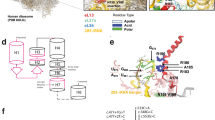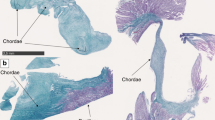Abstract
The chondrodysplasias are a heterogeneous group of disorders characterized by abnormal growth or development of cartilage1. Current classification is based on mode of inheritance as well as clinical, histologic, and/or radiographic features2. A clinical spectrum of chondrodysplasia phenotypes, ranging from mild to perinatal lethal, is due to defects in the gene for type II collagen, COL2A1. This spectrum includes Stickler syndrome, Kniest dysplasia, spondyloepiphyseal dysplasia congenita (SEDC), achondrogenesis type II, and hypochondro-genesis3,4. Individuals affected with these disorders exhibit abnormalities of the growth plate, nucleus pulposus, and vitreous humor1,5, which are tissues that contain type II collagen6. The Strudwick type of spondyloepimetaphyseal dysplasia (SEMD) is characterized by disproportionate short stature, pectus carinatum, and scoliosis, as well as dappled metaphyses (which are not seen in SEDC). The phenotype was first described by Murdoch and Walker7 in 1969, and a series of 14 patients was later reported by Anderson et al.8 The observation of two affected sibs born to unaffected parents led to the classification of SEMD Strudwick as an autosomal recessive disorder. We now describe the biochemical characterization of defects in α1 (II) collagen in three unrelated individuals with SEMD Strudwick, each of which is due to heterozygosity for a unique mutation in COL2A1. Our data support the hypothesis that some cases, if not all cases, of this distinctive chondrodysplasia result from dominant mutations in COL2A1, thus expanding the clinical spectrum of phenotypes associated with this gene.
This is a preview of subscription content, access via your institution
Access options
Subscribe to this journal
Receive 12 print issues and online access
$209.00 per year
only $17.42 per issue
Buy this article
- Purchase on Springer Link
- Instant access to full article PDF
Prices may be subject to local taxes which are calculated during checkout
Similar content being viewed by others
References
Rimoin, D.L. & Lachman, R.S. The Chondrodysplasias, in Principles and Practice of Medical Genetics, 2nd ed. (eds Emery, A.E.H. & Rimoin, D.L.) 835–932 (Churchill-Livingstone, New York, 1990).
Beighton, P. et al. International nosology of heritable disorders of connective tissue, Berlin, 1986. Am. J. med. Genet. 29, 581–594 (1988).
Vikkula, M., Metsaranta, M. & Ala-Kokko, L. Type II collagen mutations in rare and common cartilage diseases. Ann. Med. 26, 107–114 (1994).
Spranger, J., Winterpacht, A. & Zabel, B. The type II collagenopathies: a spectrum of Chondrodysplasias. Eur. J. Ped. 153, 56–65 (1994).
Murray, L.W., Bautista, J., James, P.L. & Rimoin, D.L. Type II collagen defects in the Chondrodysplasias. I. Spondyloepiphyseal dysplasias. Am. J. hum. Gene. 45, 5–15 (1989).
Miller, E.J. & Gay, S. The collagens: an overview and update. Methods Enzymol. 144, 3–41 (1987).
Murdoch, J.L. & Walker, B.A. A “new” form of spondylometaphyseal dysplasia. Birth Defects Orig. Art. Ser. V(4), 368–370 (1969).
Anderson, C.E. et al. Spondylometepiphyseal dysplasia, Strudwick type. Am. J. med. Genet. 13, 243–256 (1982).
Ala-Kokko, L. & Prockop, D.J. Completion of the intron-exon structure of the gene for human type II procollagen (COL2A1): variations in the nucleotide sequences of the alleles from three chromosomes. Genomics 8, 454–460 (1990).
Sibghat, -Ullah & Day, R.S. DNA-substrate sequence specificity of human G:T mismatch repair activity. Nucl. Acids Res. 21, 1281–1287 (1993).
El Antri, S., Mauffret, O., Monnot, M., Lescot, E., Convert, O. & Fermandjian, S. Structural deviations at CpG provide a plausible explanation for the high frequency of mutation at this site. J. molec. Biol. 230, 373–378 (1993).
Garofalo, S. et al. Reduced amounts of cartilage collagen fibrils and growth plate anomalies in transgenic mice harboring a glycine-to-cysteine mutation in the mouse type II procollagen α1 -chain gene. Proc. natn. Acad. Sci. U.S.A. 88, 9648–9652 (1991).
Bogaert, R. et al. An amino acid substitution (Gly853→Glu) in the collagen alpha1(II) chain produces hypochondrogenesis. J. biol. Chem. 267, 22522–22526 (1992).
Tiller, G.E. et al. An RNA splicing mutation (G+5IVS20) in the gene for type II collagen (COL2A1) in a family with Spondyloepiphyseal dysplasia. Am. J. hum. Genet. 56, 388–395, (1995).
Cohn, D.H., Solsky, M.A., Polumbo, P.A., Rimoin, D.L. & Tiller, G.E. A Gly817→Val substitution in α1 (II) collagen produces achondrogenesis type II. Am. J. hum. Genet. 53, 208 (1993).
Mortier, G.R. et al. Aradiographic, morphologic, biochemical, and molecular analysis of a case of achondrogenesis type II resulting from a substitution for a glycine residue (Gly691→Arg) in the type II collagen trimer. Hum. molec. Genet. 4, 285–288 (1995).
Kouseff, B.G. & Nichols, P. Autosomal recessive spondylomet-epiphyseal dysplasia, type Strudwick. Am. J. med. Genet. 17, 547–550 (1984).
Hernandez, A., Ramirez, M.L., Nazara, N., Ocampo, R., Ibarra, B. & Cantu, J.M. Autosomal recessive spondylo-epi-metaphyseal dysplasia (Irapa type) in a Mexican family. Am. J. med. Genet. 5, 179–188 (1980).
Beighton, P. Spondyloepimetaphyseal dysplasia with joint laxity (SEMDJL). J. med. Genet. 31, 136–140 (1994).
Cohn, D.H., Starman, B.J., Blumberg, B. & Byers, P.H. Recurrence of lethal osteogenesis imperfecta due to parental mosaicism for a dominant mutation in a human type I collagen gene (COL1A1). Am. J. hum. Genet 46, 591–601 (1990).
McKusick, V.A. Spondylometaepiphyseal dysplasia congenita, Strudwick type, in Mendelian Inheritance in Man, 11th ed. (ed. McKusick, V.A.) 1385–1386 (Johns Hopkins University Press, Baltimore, 1994).
Vikkula, M., Ritvaniemi, P., Vuorio, A.F., Kaitila, I., Ala-Kokko, L. & Peltonen, L. A mutation in the amino-terminal end of the triple helix of type II collagen causing severe osteochondrodysplasia. Genomics 16, 82–285 (1993).
Taybi, H. & Lachman, R.S. Radiology of Syndromes, Metabolic Disorders, and Skeletal Dysplasias. 3rd ed 795–798 (Year Book Medical Publishers, Chicago, 1990).
Eyre, D.R. Collagen crosslinking amino acids. Meth. Enzymol. 4, 115–139 (1987).
Saiki, R.K. et al. Primer-directed enzymatic amplification of DNA with a thermostable DNA polymerase. Science 239, 487–491 (1988).
Author information
Authors and Affiliations
Rights and permissions
About this article
Cite this article
Tiller, G., Polumbo, P., Weis, M. et al. Dominant mutations in the type II collagen gene, COL2A1, produce spondyloepimetaphyseal dysplasia, Strudwick type. Nat Genet 11, 87–89 (1995). https://doi.org/10.1038/ng0995-87
Received:
Accepted:
Issue Date:
DOI: https://doi.org/10.1038/ng0995-87
This article is cited by
-
Comparative analysis demonstrates cell type-specific conservation of SOX9 targets between mouse and chicken
Scientific Reports (2019)
-
Progressive pseudorheumatoid dysplasia: a rare childhood disease
Rheumatology International (2019)
-
Recurrent c.G1636A (p.G546S) mutation of COL2A1 in a Chinese family with skeletal dysplasia and different metaphyseal changes: a case report
BMC Pediatrics (2017)
-
Stickler syndrome caused by COL2A1 mutations: genotype–phenotype correlation in a series of 100 patients
European Journal of Human Genetics (2010)



